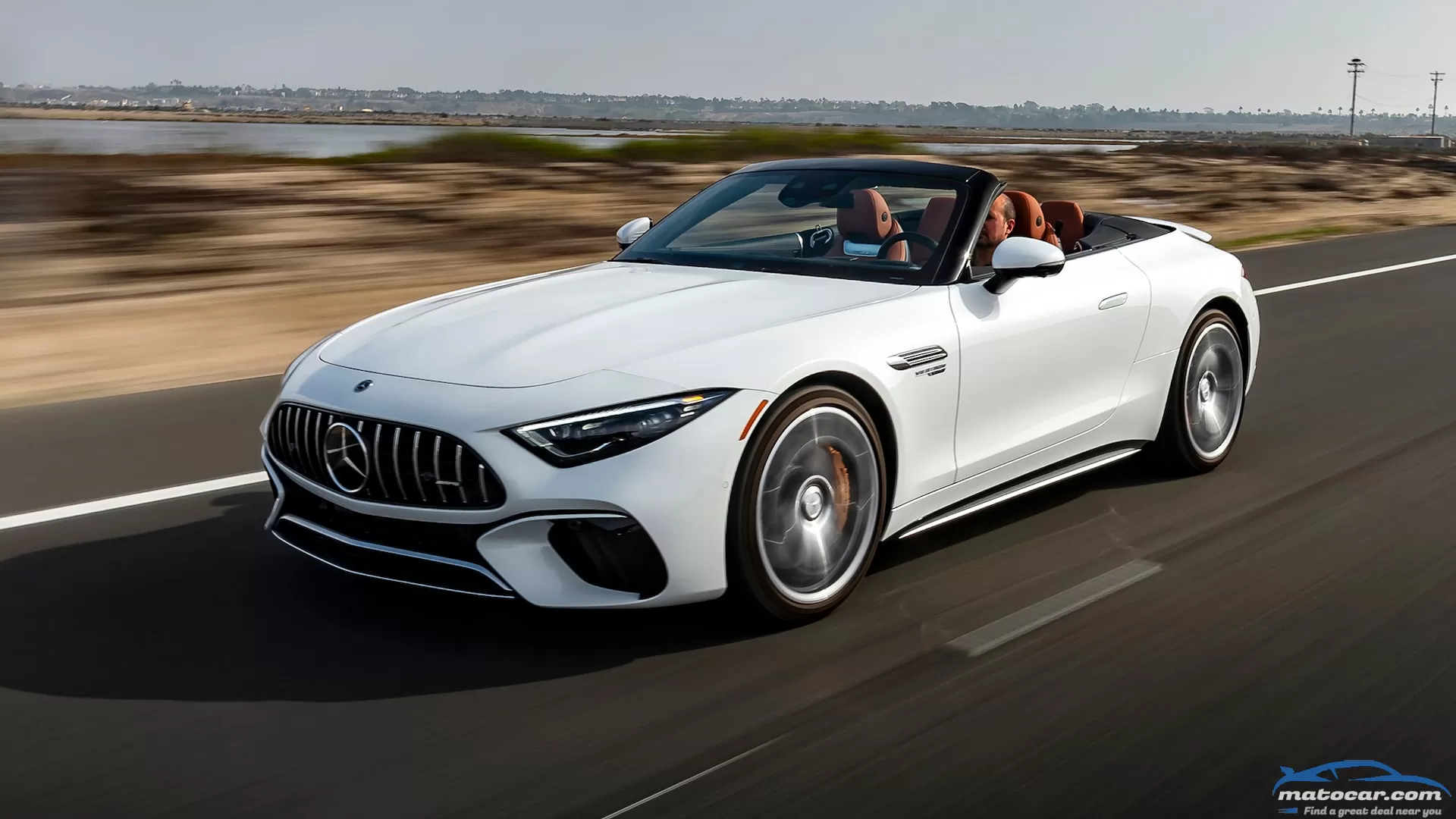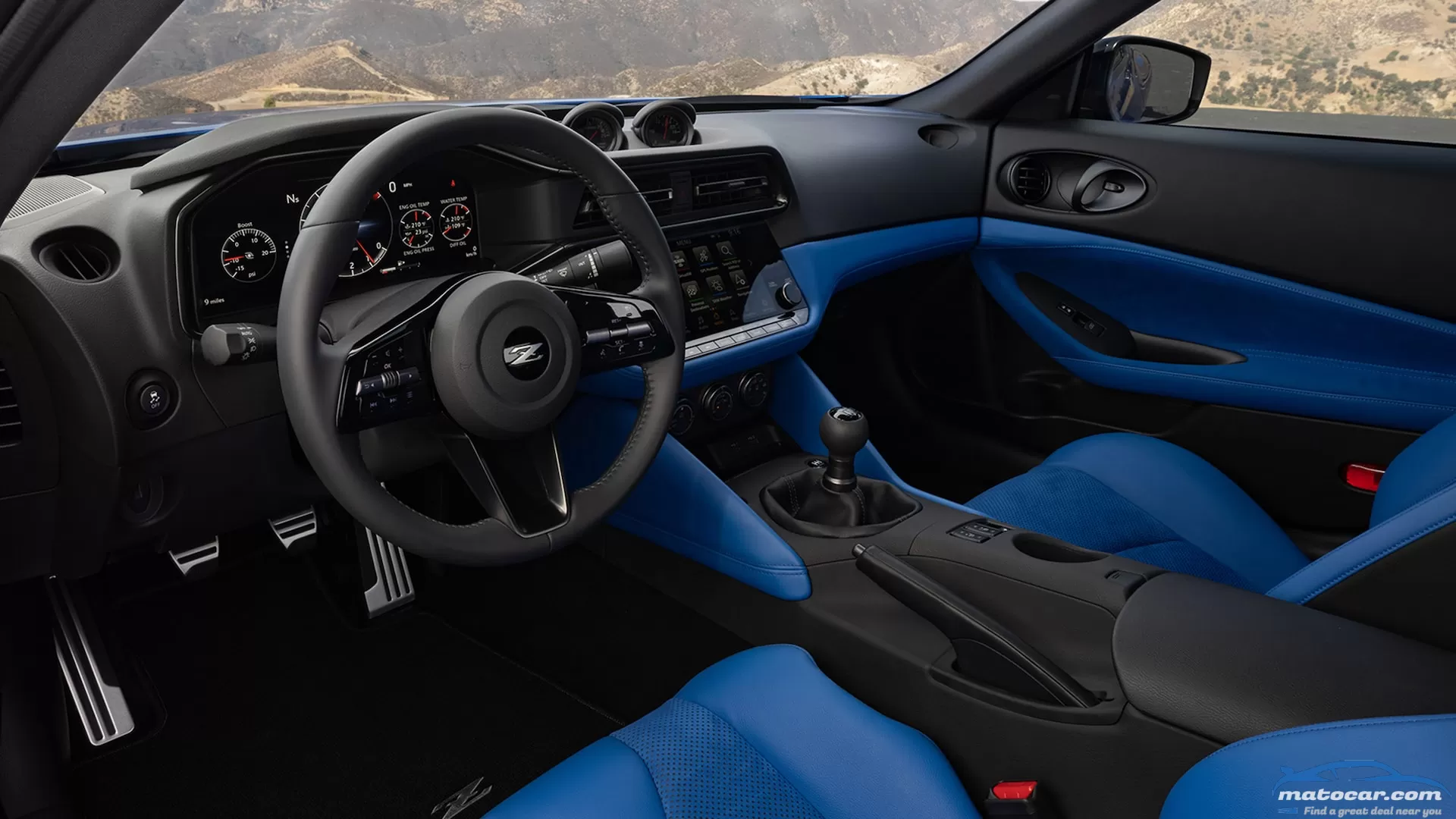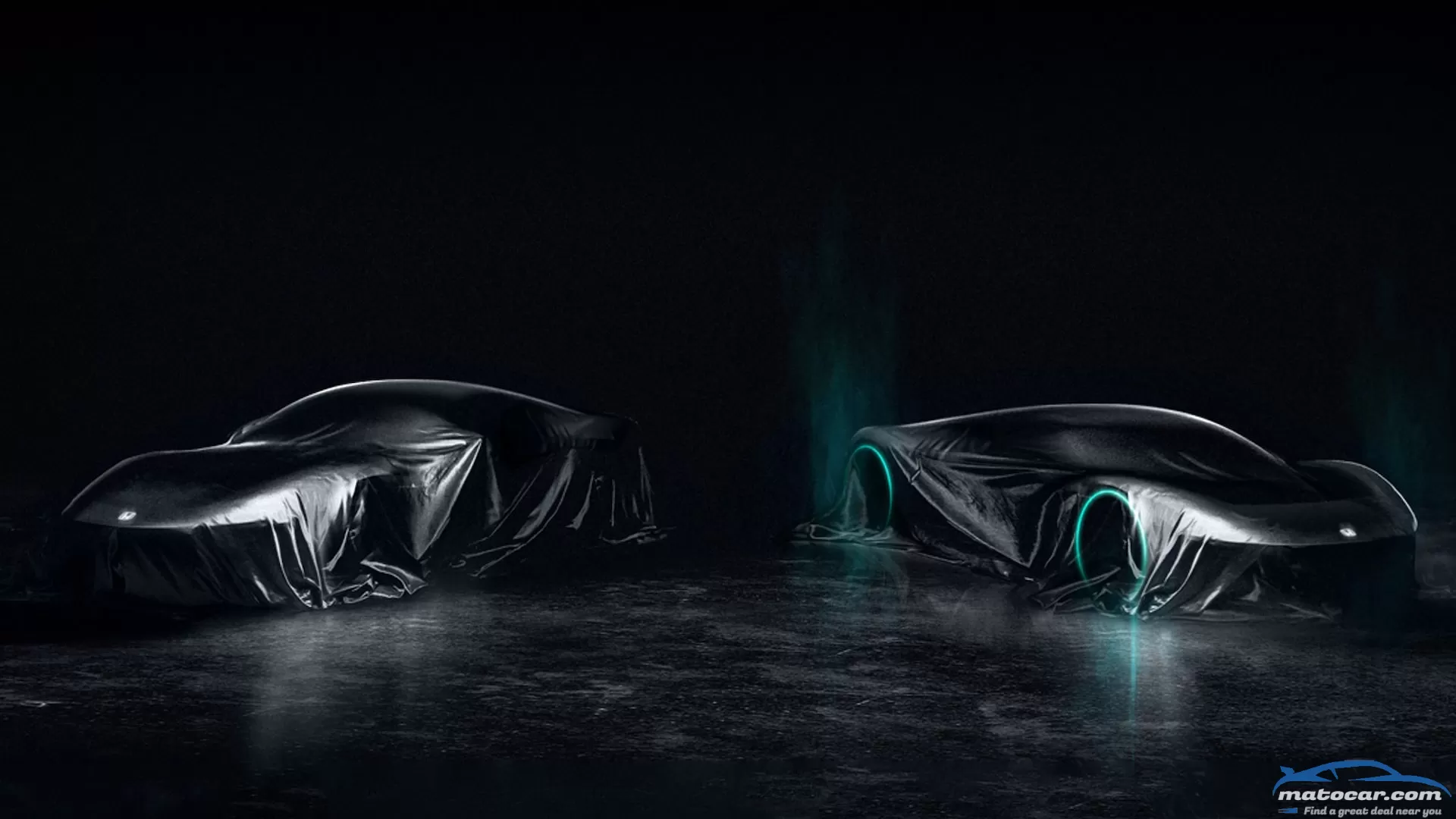Review: The New Mercedes SL Is Bigger, Better, Luxuriouser

The AMG gang in Affalterbach desperately wants you to know a few things about the 2022 Mercedes-AMG SL-Class. One, they designed it. From scratch and with little help from the Benz mothership. Two, it barely shares a screw or rivet with the AMG GT Roadster they also designed. Three, despite the new SL having grown a pair of vestigial back seats and adding a few inches in length, it promises to be the sportiest SL roadster since the racing-derived 300SL from 1957. And four, thanks to miracles of modern science, this new R232 SL also promises to deliver comfort on par with—if not exceeding—that of its Mercedes-developed R231 predecessor.
Three months of engineering roundtable Zoom calls and even a low-speed ridealong event have sufficiently satisfied us on the first two points; it's the last two that we've been itching to verify. At long last we had the opportunity to flog both the SL55 and SL63 variants on a variety of highways and twisting roads. So, has AMG managed to channel the speed-record-setting, Mille Miglia-winning verve of the original W196 while making the car even more cosseting and comfy than the outgoing roadsters?
Mercedes-AMG SL Performance in a Straight Line
The 2022 Mercedes-AMG SL63 will undoubtedly go down in our record books as the quickest SL we've tested. Mercedes claims this 577-hp, 590-lb-ft beast will dash from 0 to 60 mph in just 3.5 seconds, thanks in large part to newly standard all-wheel-drive traction that guarantees none of those ponies or pound-feet gets squandered generating tire smoke or brake heat from traction-control intervention. Converting those estimates to account for MotorTrend launch-control test conditions and a 1-foot rollout will probably boil that number down to something much closer to 3.0 seconds flat. (The last two SL models we tested each beat Mercedes' conservative estimates by exactly half a second.) The SL55, running the exact same engine but with smaller turbos and slightly less aggressive tuning produces "just" 469 horsepower and 517 lb-ft. The AMG team reckons it'll give up three-tenths to the SL63.
For some perspective, that performance should rank the SL models somewhere about even with the Porsche 911 Carrera 4S and GTS cabriolets, which is to say, ahead of the BMW M850i xDrive cab (3.9 seconds to 60 mph) and way out in front Lexus LC500 (4.7 seconds) in the bucks-up 2+2 cabrio set.
Trust us, if you never drive an SL63, that SL55 will seem like it has more than enough power. However, we might counsel those prepared to settle for the SL55 to consider opting for its AMG Dynamic Plus package, which brings with it a Race mode. We don't typically prefer Race modes because they usually disable all the stability controls, increasing amateurs' risk considerably. This one does not.
What it mostly does, in addition to heightening all the car's responses, is switch to a perfectly linear throttle response map. There's more gain earlier in the pedal travel in the Sport and Sport+ modes, which may make the car seem more eager and powerful, but at some cost to the predictability serious drivers prefer. The computer programming in Sport+ and Race modes devotes a bit of extra fuel to generating delightful pops and snorts on overrun. That feature is fun, but this mode also tends to deliver some harsher downshifts when slowing, which can feel like grabbing brakes (this never happened in Comfort mode).
We only got the SL63 up to triple-digit speeds briefly, but with the optional AMG Aerodynamics package, an air dam in front of the engine lowers 1.6 inches at speeds above 50 mph to help induce a venturi effect that helps suck the car down to the ground and reduce front-axle lift.
SL-Class Handling Behavior
These are heavy cars, pushing two-and-a-quarter tons. But AMG Active Ride Control, which connects opposite corners of the car hydraulically to limit body roll (as on various McLaren cars and now Rivian trucks), truly makes them feel as agile as cars weighing a half-ton less. This is another feature that's standard on the SL63, and available to help make your SL55 cost almost as much as a 63.
Clicking the steering-wheel-mounted drive mode selector clockwise relaxes the stability nannies somewhat, making the cars progressively more neutral in their handling demeanor, but there's no "drift mode," no option to bar torque from reaching the front axle. (That's right—unlike the AMG GT family, the SLs are all-wheel drive.) And hence, even an aggressive drive up Mount Palomar on a cool morning with slightly dewy road surface, we never once sensed Race mode allowing the tail to run wide. More than a little credit here is due the Michelin Pilot Sport 4S tires—265/40 front, 295/35 rear on the standard 20-inch rims, or 275/35 front and 305/30 on the optional 21s we mostly ran.
The carbon-composite brakes deserve honorable mention for being equally adept at shedding heroic speeds upon approach to a tightening-radius corner—corner after corner—as they are at executing a limousine stop in town. Both models share this standard six-piston front, single-piston rear brake system.
Steering feel changes as you switch modes, and we generally found the comfort mode to be a bit too light. The other modes don't heighten the driver's feel for the road, per se, but the firmer helm feels better. We were blissfully unaware of the four-wheel steering (standard on both models) doing its thing, except when executing exceptionally tight U-turns.
The California roads between Newport Beach and Palm Springs are relatively smooth, but we aimed for the bumpiest patches we could find and were impressed by the suspension compliance afforded in Comfort mode. The Sport and Race modes firm things up noticeably enough that we took the time to program the Individual mode with everything set to its raciest option and the suspension set to Comfort. This was our Goldilocks "just right" setting, but we also appreciated that individual characteristics (steering, ride, exhaust noise, etc.) can be easily adjusted on the fly using the round selector and twin toggle switches at the lower left side of the wheel, just opposite the main mode-selector switch. The super-rigid multi-material structure never seemed to twist or jiggle in response to bumps.
What's the Mercedes-AMG SL-Class Like to Live With?
Mostly wonderful. The cabin seems as quiet with the soft top up as the previous model did with its folding hard top raised. The Z-fold fabric roof lowers in 15 seconds at the touch of a button, and a switch allows all four windows to be lowered simultaneously. Happily, the sun visors swivel out, unlike on some convertibles. Raise the windows and pull up the mesh-screen wind blocker that covers the rear "seat" to keep the cabin remarkably calm and quiet even at highway speeds. In cooler weather, switch on the Airscarf neck-warmer to extend the top-down season (the cockpit isn't long enough to need the E-Class convertible's Air Cap windshield header air-management screen).
The center info screen adjusts between 12 and 32 degrees to prevent sun from reflecting directly into the driver's eyes, though the buttons for adjusting this (and for raising and lowering the top) can be hard to see when that glare prompts you to fix the screen. We're also not completely sold on a lot of the capacitive switchgear in use here. The mirror switch, for example, didn't seem to respond as expected. We have yet to experience capacitive switches we love.
As with all new Mercedes products, the all-digital instrument cluster can be set to display any of several different themes and tons of information, the most pertinent of which is redundantly shown on the head-up display (standard on 63, optional on 55). Track Pace screens will help folks monitor and improve their performance on their car country club track, and the additional stowage space behind the front seats and in the trunk should make the new SL much more useful as a daily driver.
We reckon the new car is comfortable enough to retain the SL faithful and sporty enough to pull some customers out of 911s, the BMW 8 Series, and Lexus LCs. Of those, the BMW's nearly 5 inches of added wheelbase gives it a slightly more usable rear seat (the SL's is only rated for passengers shorter than 5 feet tall). A lighter Porsche will always feel nimbler, and the Lexus design may turn more heads, but this Mercedes-AMG enjoys nearly seven decades of heritage, and this R232 pays legitimate homage to its very best SL progenitors.
When and How Much?
The 2022 Mercedes-AMG SL-Class will go on sale in the second quarter of 2022. Mercedes isn't talking pricing just yet, but it seems a safe bet to assume that since the new 2+2-seat SL is effectively replacing both the four-seat S-Class cabriolet and two-seat R231 Mercedes-Benz SL-Class, pricing should represent an average of these models. Let's figure $132K for the SL55 and $175K for the SL63. That prices the new SL right in the thick of the 2+2-passenger convertible crowd.
Looks good! More details?2022 Mercedes-AMG SL-Class Specifications BASE PRICE $132,000-$175,000 (est) LAYOUT Front-engine, AWD, 2+2-pass, 2-door convertible ENGINE 4.0L/469-577-hp/516-590-lb-ft twin-turbo direct-injected DOHC 32-valve V-8 TRANSMISSION 9-speed auto CURB WEIGHT 4,300-4,400 lb (est) WHEELBASE 106.3 in L x W x H 185.2 x 75.4 x 53.5 in 0-60 MPH 3.5-3.8 sec (mfr est) EPA FUEL ECON 16/21/18 mpg (est) EPA RANGE (COMB) 350 miles (est) ON SALE 2nd Quarter 2022 Show AllYou may also like
As you're probably aware, there's an ever-diminishing roster of cars available with a manual transmission. But that doesn't mean there aren't still choices. While manual cars no longer can be counted on to save money at the gas pump—today's automatics are generally more efficient—for a certain subset of the population, including many of us here at MotorTrend, there's nothing like a car, truck, or SUV with three pedals.Among the changes to this list for 2022, the sole entrant from Lotus has sailed into the sunset, while a renewed sports car by Nissan joins the analog squad. In 2021 we also said au revoir to the iconic VW Golf, at least here in America. The workaday Hyundai Veloster got the axe and now only exists in N form, and Aston Martin has decided to kill the manual from its upcoming lineup. Finally, the Genesis G70, Hyundai Accent, and Kia Soul have also parted ways with the manual transmission for the 2022 model year. But there are still holdouts, thank goodness; read on to find out where you can still exercise your left foot.
Laying It OutNumbers Upon NumbersUp in the CanyonsSummary Judgment2nd Place: 2022 Acura NSX Type SProsInteresting drivetrain techMid-range torqueMid-engine architecture ConsBrakes don't inspire confidenceVague steering feelExpensive for what you getVerdict:1st Place: 2022 Porsche 911 Carrera GTSProsQuick in a straight lineQuick in cornersSupreme handling ConsUbiquitous on the streetNot as sharp as some other 911sToo pricey for most peopleVerdict:POWERTRAIN/CHASSIS 2022 Acura NSX Type S Specifications 2022 Porsche 911 Carrera GTS Specifications DRIVETRAIN LAYOUT Mid-engine, 2 front and 1 rear motors, AWD, 2-pass, 2-door coupe Rear-engine, RWD ENGINE, MOTOR TYPE Twin-turbo port- and direct-injected DOHC 24-valve 60-degree V-6, plus 3 permanent-magnet elec motors Twin-turbo direct-injected DOHC 24-valve flat-6, alum block/heads DISPLACEMENT 3,454 cc/210.8 cu in 2,981 cc/181.9 cu in COMPRESSION RATIO 10.0:1 10.2:1 POWER (SAE NET) 520 hp @ 6,500 rpm (gas), 72 hp (comb front elec), 47 hp (rear elec); 600 hp (comb) 473 hp @ 6,500 rpm TORQUE (SAE NET) 443 lb-ft @ 2,300 rpm (gas), 108 lb-ft (comb front elec), 109 lb-ft (rear elec); 492 lb-ft (comb) 420 lb-ft @ 2,300 rpm REDLINE 7,500 rpm 7,400 rpm WEIGHT TO POWER 7.5 lb/hp 7.2 lb/hp TRANSMISSION 9-speed twin-clutch auto 8-speed twin-clutch auto AXLE/FINAL-DRIVE RATIO 3.58:1/2.27:1 3.39:1/2.07:1 SUSPENSION, FRONT; REAR Control arms, coil springs, adj shocks, anti-roll bar; multilink, coil springs, adj shocks, anti-roll bar Struts, coil springs, adj shocks, anti-roll bar; multilink, coil springs, adj shocks, anti-roll bar STEERING RATIO 11.1-12.9:1 12.3-14.1:1 TURNS LOCK-TO-LOCK 1.8 2.4 BRAKES, F; R 15.0-in vented, drilled carbon-ceramic disc; 14.2-in vented, drilled, carbon-ceramic disc 16.1-in vented, drilled, carbon-ceramic disc; 15.4-in vented, drilled, carbon-ceramic disc WHEELS, F;R 8.5 x 19-in; 11.0 x 20-in, forged aluminum 8.5 x 20-in; 11.5 x 21-in, forged aluminum TIRES, F;R 245/35R19 93Y; 305/30R20 103Y Pirelli P Zero HO 245/35R20 91Y; 305/30R21 100Y Pirelli P Zero NA1 DIMENSIONS WHEELBASE 103.5 96.5 in TRACK, F/R 65.5/64.5 in 62.8/61.3 in LENGTH x WIDTH x HEIGHT 178.5 x 76.3 x 47.8 in 178.4 x 72.9 x 50.9 in TURNING CIRCLE 39.7 ft 35.8 ft CURB WEIGHT (DIST F/R) 3,903 lb (42/58%) 3,389 lb (37/63%) SEATING CAPACITY 2 2 HEADROOM 38.3 in 37.9 in LEGROOM 42.9 in 42.2 in SHOULDER ROOM 57.5 in 56.2 in CARGO VOLUME 4.4 cu ft 4.7 (trunk), 9.3 (rear parcel) cu ft TEST DATA ACCELERATION TO MPH 0-30 1.3 sec 1.2 sec 0-40 1.8 1.7 0-50 2.4 2.2 0-60 3.1 2.9 0-70 3.9 3.7 0-80 4.8 4.6 0-90 5.9 5.7 0-100 7.1 7.0 0-100-0 11.3 10.8 PASSING, 45-65 MPH 1.4 1.3 QUARTER MILE 11.2 sec @ 124.1 mph 11.1 sec @ 124.6 mph BRAKING, 60-0 MPH 103 ft 99 ft LATERAL ACCELERATION 1.03 g (avg) 1.04 g (avg) MT FIGURE EIGHT 23.2 sec @ 0.89 g (avg) 23.3 sec @ 0.87 g (avg) TOP-GEAR REVS @ 60 MPH 1,500 rpm 1,500 rpm CONSUMER INFO BASE PRICE $171,495 $138,050 PRICE AS TESTED $185,995 $162,940 AIRBAGS 7: Dual front, front side, front curtain, driver knee 8: Dual front, front side, f/r curtain, front knee BASIC WARRANTY 4 yrs/50,000 miles 4 yrs/50,000 miles POWERTRAIN WARRANTY 6 yrs/70,000 miles 4 yrs/50,000 miles ROADSIDE ASSISTANCE 4 yrs/50,000 miles 4 yrs/50,000 miles FUEL CAPACITY 15.6 gal + 1.3 kWh Li-Ion 23.7 gal EPA CITY/HWY/COMB ECON 21/22/21 mpg 17/23/19 mpg EPA RANGE, COMB 328 miles 450 miles RECOMMENDED FUEL Unleaded premium Unleaded premium ON SALE Now Now Show All
WHAT IT IS: Honda plans to launch two electric sports cars in the medium term. The first is dubbed a "specialty model," and based on the teaser image Honda shared, it looks like it will have the proportions of a smaller, more affordable sports car. The return of the S2000 doesn't sound like a crazy idea, especially when everyone is resurrecting old model names. This will be the company's first electric sports car, but not its only one. The second model will serve as a halo, and based on its proportions, it looks like an Acura NSX with a wilder form. Honda hasn't said if both cars will carry the Honda brand name, but given the NSX falls under Acura for the North American market, it won't surprise us to see such a strategy continue.WHY IT MATTERS: As everyone goes electric, Honda has been one of the most conservative automakers to make the change. This move puts Honda on the radar, as the Japanese company aims to sell more than 500,000 electric vehicles in North America later this year. With the Acura NSX leaving production after the 2022 model year, this electric halo car could mark its return. And who won't be excited by an S2000-inspired electric car?PLATFORM AND POWERTRAIN: It's too early to know the details, but these two cars will be based on Honda's own electric vehicle platform, dubbed e:Architecture. Yes, Honda is working with General Motors to launch two SUVs—the Prologue and an unnamed Acura crossover—but the two sports models will be developed completely by Honda. We estimate each car will have at least 300 miles of range and a scintillating driving experience.ESTIMATED PRICE: The "specialty model" should start at less than $50,000, but the halo model will most likely cost more than $150,000.EXPECTED ON-SALE DATE: 2026 for the small model and 2027 for the halo car.




0 Comments